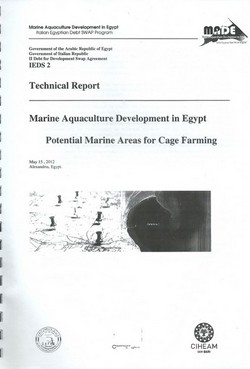
Marine Aquaculture Development in Egypt
Potential Marine Areas for Cage Farming
Introduction:-
- Main consideration on marine aquaculture in Egypt.
Inland aquaculture is developed in Egypt, but changing water qualities (like heavy metals concentration, pollution) and the need to expend production to provide fish for national market in a situation of fast increasing population, requires new production spaces.
The Mediterranean side in mainly excessively exposed to water dynamic and only few locations seem to have real potential.
Probably other solutions, as eather from the sea will be considered for the Mediterranean side, where high hidrodynamism affect cage structures resistance, and where grounds beyond the shoreline are not used for agriculture because of the high content of salt in the water.
The Red Sea and Suez Gulf can offer more suitable locations thus protected reefs, touristic areas, industrial and military spots, must be carefully excluded.
Selection criteria:-
- The area should be far from touristic site (natural parks, protected areas, beaches and diving sites).
- The cage location must not be chosen in exposed areas (waves, wind, estuarine influence, pollution waters).
- The area should be located in deep water, enough to reduce environmental impact through pollutants dispersion operated by streams.
- The farming activity should not interfere with other human activities such as naval traffic, oil extraction and army activities.
- Being near to main roads, railways station and airports is a clear advantage.
- Landing site and places with piers or harbors can offer better chances for installation and transport of the cages, mooring systems etc.
- Inland settlement of a facility, raceways or tanks for quarantine/rearing fry and were to organize any post harvesting action, is highly recommended.
Environmental constrains:-
Near shore and offshore cage systems may be a couse of environmental impact such as disease transmission, nutrient loading around farm sites and escapees (genetic pollution).
Expansion of cage culture in areas such as the Red Sea, where cage sites may be close to sensitive coral reef would also require monitoring impacts and the nutrient loading of the nearby ecosystem. Cage culture environmental impacts are site-specific and, while water exchange rates and dilution factors in many areas are sufficient to prevent excess nutrient loading, each site a carrying capacity that needs to be considered.
Contents:-
- Introduction
- Selected locations
- Satelite photos and specific comments
- Aquaculture sites and facility development



ساحة النقاش